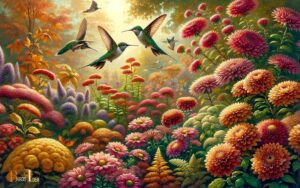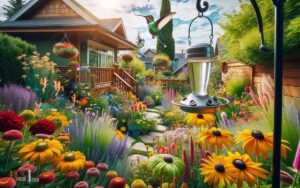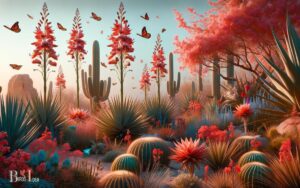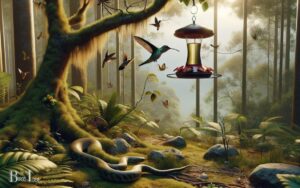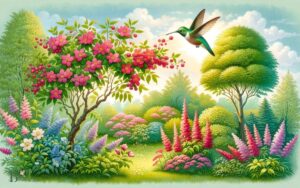Annuals That Attract Hummingbirds and Butterflies: Discover!
Selecting the right annual plants can significantly enhance your garden’s appeal to hummingbirds and butterflies.
For hummingbirds, consider planting nectar-rich flowers such as salvia, petunias, and fuchsia. These vibrant blossoms provide the necessary fuel for the high-energy birds.
Butterflies, on the other hand, are attracted to brightly colored flowers with flat, open shapes, like zinnias, marigolds, and lantanas.
Include a variety of these annuals in your garden to ensure a continuous blooming period, providing a sustained food source for these delightful pollinators.
With careful selection, your garden can become a haven for both hummingbirds and butterflies throughout the growing season.
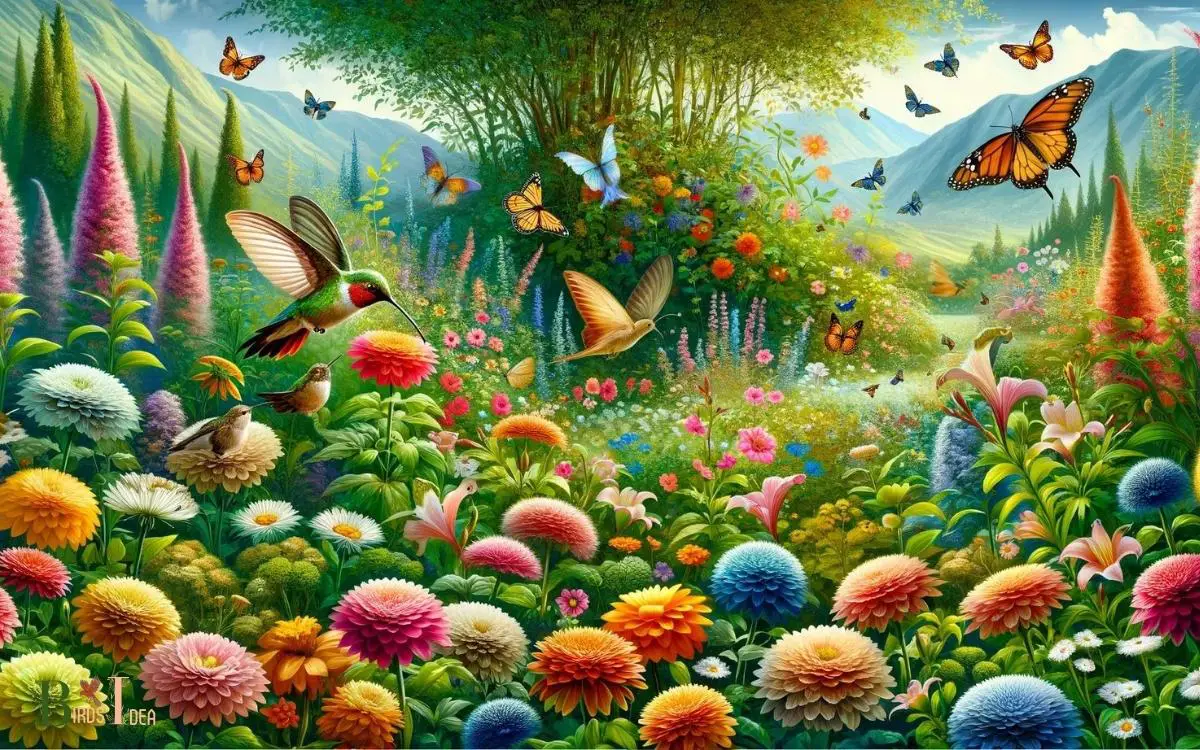
Key Takeaway
Importance of Attracting Pollinators
Attracting pollinators is essential for annual gardens to thrive and flourish throughout the growing season.
Hummingbirds and butterflies are vital pollinators that facilitate the reproduction of many annual plants.
These beautiful creatures transfer pollen from one flower to another, allowing for fertilization and the production of seeds.
Without pollinators, many annuals would not be able to produce the fruits and seeds necessary for the next generation of plants.
In addition to the practical benefits, attracting pollinators also adds natural beauty and movement to the garden, enhancing the overall aesthetic.
By choosing the right annuals that appeal to hummingbirds and butterflies, gardeners can create a welcoming environment that supports these important pollinators while enjoying a vibrant and lively garden throughout the season.
Best Annuals for Hummingbirds
Annuals that attract hummingbirds are a delightful addition to any garden. These plants feature bright, nectar-rich blooms that are irresistible to hummingbirds. Best of all, they are easy to grow, making them perfect for gardeners of all skill levels.
Bright, Nectar-Rich Blooms
Hummingbirds frequently seek out bright, nectar-rich blooms when foraging for food. These annuals are excellent choices for attracting hummingbirds due to their vibrant colors and high nectar content.
When selecting annuals to plant in the garden, consider the following options:
- Salvia: Also known as sage, this plant produces long, tubular flowers that are rich in nectar, making them a favorite of hummingbirds.
- Zinnia: With its colorful, daisy-like flowers, zinnias provide a good source of nectar and are easy to grow, making them a popular choice for attracting hummingbirds.
- Lantana: Lantana’s clusters of tiny, brightly colored flowers are a magnet for hummingbirds and butterflies, thanks to their abundant nectar.
These annuals not only add beauty to the garden but also provide essential nourishment for these delightful, tiny birds.
Easy-To-Grow Garden Additions
Easy-to-grow garden additions that are best for attracting hummingbirds include several annuals with vibrant, nectar-rich blooms.
Salvia, also known as sage, is a top choice, with its long, tubular flowers that hummingbirds love.
Another excellent option is the zinnia, which comes in a variety of colors and sizes, providing a buffet of nectar for hummingbirds.
Also, the petunia is a favorite annual that attracts hummingbirds with its trumpet-shaped flowers.
These annuals are not only easy to grow but also add a burst of color and natural charm to any garden.
By incorporating these vibrant blooms into the garden, one can create a welcoming environment for hummingbirds while enhancing the overall beauty of the space. Next, let’s explore the top choices for butterfly gardens.
Top Choices for Butterfly Gardens
When planning a butterfly garden, it’s important to select annuals that provide nectar and host plants for butterflies to lay their eggs. The following are some top choices for butterfly gardens:
Nectar Plants
- Zinnias
- Lantanas
- Marigolds
Host Plants
- Milkweed
- Parsley
- Dill
These annuals not only provide a food source for adult butterflies but also offer a place for them to lay their eggs and for the caterpillars to feed once they hatch.
By including a variety of nectar and host plants in the garden, one can attract a diverse range of butterfly species and support their entire life cycle.
Designing a Hummingbird and Butterfly Garden
Designers can create a hummingbird and butterfly garden by strategically incorporating a variety of annuals that provide nectar and host plants for these pollinators’ life cycles.
When designing the garden, it’s essential to select a mix of annuals that bloom at different times throughout the growing season to ensure a continuous food source for hummingbirds and butterflies.
Consider including bright, tubular flowers like salvia, zinnias, and pentas to attract hummingbirds, while also including milkweed, dill, and parsley to serve as host plants for butterflies.
Additionally, incorporating a variety of heights and colors will make the garden more visually appealing and provide different options for the pollinators.
By carefully planning the layout and plant selection, designers can create a vibrant and welcoming space for hummingbirds and butterflies to thrive.
Planting and Caring for Annuals
How can one ensure the flourishing of annuals that attract hummingbirds and butterflies? To ensure the success of these beautiful plants, it’s essential to provide the right care and environment.
Here are some tips for planting and caring for annuals:
- Select the Right Location: Choose a spot with well-drained soil and sufficient sunlight for the annuals to thrive.
- Proper Watering: Water the plants regularly, keeping the soil consistently moist but not waterlogged.
- Deadheading and Pruning: Remove faded flowers and prune the plants as needed to promote continuous blooming.
Creating a Colorful and Nectar-Rich Habitat
When creating a colorful and nectar-rich habitat, it’s essential to carefully select plants that are rich in nectar to attract hummingbirds and butterflies.
The key lies in choosing annuals that are known to be effective attractants for these beautiful creatures.
Additionally, incorporating a thoughtful and vibrant garden design can further enhance the appeal of the habitat.
Nectar-Rich Plant Selection
Gardeners often seek out nectar-rich annual plants to create a colorful and nectar-rich habitat for attracting hummingbirds and butterflies.
When selecting nectar-rich plants, consider the following:
Colorful Varieties
- Opt for vibrant annuals such as zinnias, salvias, and ageratum to add a pop of color to the garden while attracting pollinators.
- Look for varieties with red, orange, and pink blooms, as these hues are particularly attractive to hummingbirds.
Long-Blooming Species
- Choose annuals like petunias, verbena, and lantanas that offer an extended flowering period, providing a consistent nectar source for visiting hummingbirds and butterflies.
- Selecting plants with staggered bloom times ensures a continuous nectar supply throughout the growing season.
Native Plant Options
- Incorporate native annual species, such as penstemon, columbine, or bee balm, to support local pollinators and create a thriving ecosystem.
- Research native annuals that are well-suited to the specific growing conditions in your region.
Hummingbird and Butterfly Attractants
Surprisingly, creating a colorful and nectar-rich habitat to attract hummingbirds and butterflies doesn’t have to be complicated.
By selecting a variety of annual plants with vibrant, tubular flowers, such as salvia, petunias, and zinnias, gardeners can easily appeal to these delightful creatures.
Additionally, incorporating flowering shrubs like butterfly bush and bee balm can provide a long-lasting source of nectar.
It’s essential to choose plants with staggered bloom times to ensure a consistent nectar supply throughout the growing season.
To further entice hummingbirds and butterflies, consider adding a water feature, like a birdbath or small fountain, as these creatures also need water for drinking and bathing.
By combining these elements, gardeners can create an inviting and visually appealing environment that will attract and support these beautiful pollinators.
Attracting Hummingbirds and Butterflies With Annual Containers
One effective way to attract hummingbirds and butterflies is by setting up annual containers filled with nectar-rich flowers.
These containers can be strategically placed on patios, near windows, or along garden pathways to create easy viewing opportunities.
When choosing plants for the containers, it’s important to select a variety of annuals that bloom at different times throughout the season to provide a continuous nectar source for the hummingbirds and butterflies.
Some great options include petunias, zinnias, salvias, and lantanas. These vibrant flowers not only add beauty to the garden but also serve as a vital food source for these delightful pollinators.
By incorporating annual containers filled with nectar-rich flowers, gardeners can create inviting spaces that attract and support hummingbirds and butterflies.
This approach seamlessly leads to the subsequent section about maintenance tips for a thriving garden.
Maintenance Tips for a Thriving Garden
To ensure a thriving garden that continues to attract hummingbirds and butterflies, regular maintenance is essential.
Here are some tips for maintaining a garden that is attractive to these beautiful creatures:
- Pruning and Deadheading: Regularly prune and deadhead flowers to promote new growth and continuous blooming, which provides a consistent food source for hummingbirds and butterflies.
- Weed Control: Keep the garden free from weeds that compete with annuals for nutrients and water, ensuring that the plants remain healthy and vibrant.
- Watering and Feeding: Monitor the garden’s moisture levels and provide regular fertilization to support the vigorous growth of annuals, which in turn sustains the nectar supply for hummingbirds and butterflies.
Conclusion
Attracting hummingbirds and butterflies to your garden can be a piece of cake with the right annuals and a little bit of effort.
By planting colorful and nectar-rich flowers, you can kill two birds with one stone, creating a vibrant and lively environment while supporting important pollinators.
So why not take the bull by the horns and start planting your own hummingbird and butterfly garden today? It’s a win-win situation for both you and nature.

